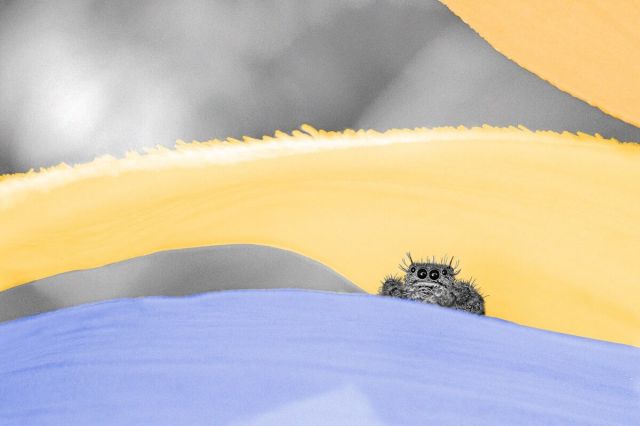
Not All Spiders Make Webs
Spiders and webs are inseparable in our minds – what’s a Halloween decoration without both? In fact, only about half of all species of spiders make webs. The others catch their food without a web: Like other predators, they may either actively stalk their prey, or else wait hidden to pounce when it passes by. All spiders do make silk, though. They may just use it for other purposes, such as creating egg sacs or getting from place to place.

Not All Spider Webs Look Like Stereotypical Spider Webs
The Halloween-decoration type of spider web – called an orb web — isn’t the only kind. In fact, it’s not even the most common. Spiders make at least three other kinds of webs. Sheet webs are what they sound like: The silk threads form something like a sheet of thin gossamer fabric. Unlike the orb web, this isn’t a sticky trap – it’s more like a net that catches insects as they fly, knocking them off-course so they fall to the spider waiting below. Some species make funnel-shaped webs, which can be used as hideaways or storage areas. And then there are cobwebs, which are a tangle of sticky silk.

Spiders Won’t Thank You for Putting Them Outside
Many of us don’t want spiders in our house, but don’t want to be spider-murderers either, so we catch them and put them outside. This might seem like a nice thing to do, but chances are you’re evicting that spider from its lifelong home. For many species of spiders, our houses are their natural habitat, and some won’t survive long outside it. In fact, your home is an ecosystem that supports a wide range of arthropods (the group that includes spiders and insects, among other creatures). One study of 50 homes in and around Raleigh, North Carolina, found species from 15 families of spiders, and one group, the cobweb spiders, were found in 100% of the houses studied.
More Interesting Reads

The Vast Majority of Spiders Can’t Hurt You
If learning about all the spiders that share your house has freaked you out, don’t worry! Yes, almost all spiders use venom to subdue their prey, but out of the over 45,000 known species, only a handful pose any danger to humans. Since we’re much too big for them to eat, they usually have no reason to bite us, so spider bites are far less common than people think. In one case where researchers collected 2,055 brown recluse spiders from a home in Kansas, none of the residents had ever been bitten. In fact, the much-feared brown recluse only appears in the south-central U.S., so if you live anywhere else in the country, you can stop worrying. Of course, it’s still important to treat any spider you find with care.

Some Spiders Are Social
Most spiders are solitary, but some species are social animals. They live together in shared webs or groups of webs, and some cooperate in hunting and even raising young. Large webs catch prey more effectively, and a group of spiders can subdue prey that is 10 times their body weight (a single spider can usually only handle something twice as big as itself). The large webs also provide shelter for the spiders and protection from their own predators. Colony sizes can be as small as a handful or as much as tens of thousands of individuals. Don’t fret, however — this isn’t the kind you’ll find in your house.











